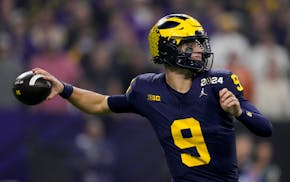AUGUSTA, GA. - Angel Cabrera looks like an extra in a mobster movie. He walks like he's trying to stamp out a campfire. His reputation precedes him, and so does his belly.
When he won the U.S. Open at Oakmont in 2007, Cabrera dismissed an entire pampered generation of pro golfers by saying, "Some players use a sports psychologist. I smoke." When he made it into the final pairing at the 2009 Masters, he said, "Now I don't need a sports psychologist and I don't smoke."
Except, perhaps, for victory cigars. Sunday afternoon, Cabrera hacked and grinned his way through one the most tumultuous final rounds in Masters history, beating Kenny Perry and Chad Campbell in a playoff between pear-shaped guys with idiosyncratic swings.
What the rest of us need now is a sports psychologist who can explain how a former caddie can make the U.S. Open and Masters his first two victories on the PGA Tour, how a guy can hit a tree on a playoff hole and survive, how someone nicknamed "Duck" can beat a Tiger.
"A lot of magical things happen," Cabrera said. "It's simply the Masters."
Anyone complaining about a lack of roars on Sunday at Augusta National in recent years should have watched this edition, which included an equal number of gasps and groans. Tiger Woods and Phil Mickelson, seven shots off the lead and paired together, tore up the front nine to move into contention. "I was in awe of what they were doing in front of me," Perry said. "I was hoping they would have a little boxing match."
They punched themselves out. Mickelson shot a 30 on the front and climbed to within a shot of Perry's lead, but made a double bogey after hitting into the creek on 12, and missed short eagle and birdie putts the next two holes, and Perry took command with a majestic tee shot on the par-3 16th that left him a tap-in birdie and a two-shot lead.
Perry bogeyed the last two holes, and when Cabrera got up-and-down for par on the 18th, he found himself in the fifth three-way playoff in Masters history.
So the threesome went back to the 18th tee. Campbell and Perry hit the fairway, while Cabrera, for the second time in minutes, drove into the trees on the right.
This time his escape shot hit a tree and bounced into the fairway. He hit his third shot about 10 feet above the hole and sank the putt.
Then he walked to the back of the green, smiled at the gallery, and exhaled like he had just walked away from a car wreck.
"At this stage of the tournament," Cabrera said, "any player who says he does not feel nerves -- he's not human." Campbell missed a short putt and was done, and Perry and Cabrera took the short walk to the 10th tee.
Perry hooked his approach into the valley left of the green, and Cabrera finessed a fade below the hole. Two putts later, he became only the 15th player to win a U.S. Open and Masters, something Johnny Miller, Lee Trevino, Sam Snead and Walter Hagen never did. Among active players, only Cabrera and Woods -- the Duck and the Tiger -- have won both. Strangely, Cabrera did not finish in the top 10 of a PGA stroke-play event between his major titles.
Cabrera, an Argentinian, became the first player from South America to win a Masters, but not the first Argentinian to qualify for a Masters playoff. In 1968, Roberto De Vicenzo shared the lead after 72 holes with Bob Goalby, but submitted an incorrect scorecard and was disqualified.
When Cabrera won the U.S. Open, De Vicenzo honored him. "He gave me a frame where he has in his hand a green jacket," Cabrera said. "He says, 'I hope this gives you luck so someday you can bring back a green jacket for yourself.'"
Maybe Cabrera had a sports psychologist on his side after all.
Jim Souhan can be heard Sundays from 10 a.m.-noon on AM-1500 KSTP. jsouhan@startribune.com

Souhan: These seven plays showcase Wolves' new defensive fire

Souhan: Wolves fans made Game 1 special. Now bring on Game 2.

Souhan: Should Vikings even consider McCarthy in NFL draft?

Souhan: NAW erases Suns' lead, Game 1 advantage with big performance

